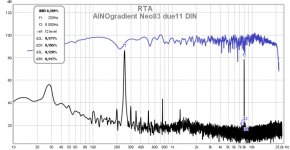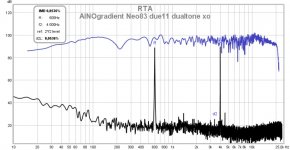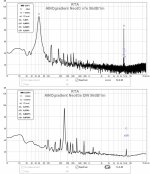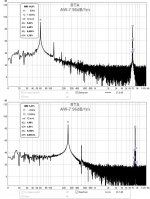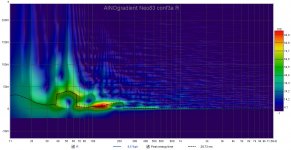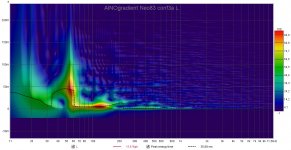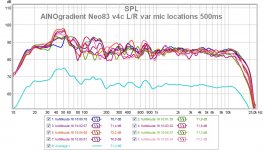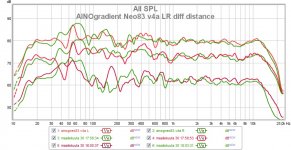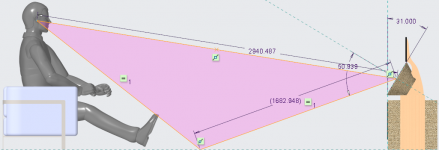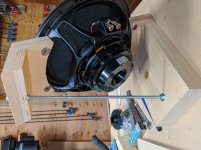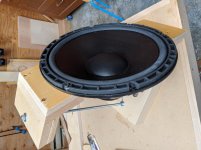Thanks Juha, that makes sense to me.
A different opinion from Robert E. Greene's review of the Gradient 1.3
The Gradient 1.3 Revisited
I don't understand this entirely. .
still it is a real audible problem
Thank you graaf! Links in your post from 2016 are broken, but a web search for "Archimedes project sound Bech" produced some papers on topic. Will look into these!
Those interested in bass directivity control should study these modern designs
Dutch&Dutch 8c - cardioid down to 100Hz, monopole below
Kii Audio Three BXT - cardioid down low
Genelec W371A - dsp based directivity control, options
Dutch&Dutch 8c - cardioid down to 100Hz, monopole below
Kii Audio Three BXT - cardioid down low
Genelec W371A - dsp based directivity control, options
Those are truly amazing speaker systems that I've read about in the past, though I was unaware of the Genelec system. Price tags are well above $10,000 however, and such implementations are probably beyond the potential of 99.9% of diyaudio members to replicate or even begin to approach: I speak for me, anyway. Interesting that they're mostly utilizing cardioid bass. Can anyone who has listened to any of these systems comment on their experience here? (That's if Juha doesn't mind his AINO thread getting cluttered...)Those interested in bass directivity control should study these modern designs
Dutch&Dutch 8c - cardioid down to 100Hz, monopole below
Kii Audio Three BXT - cardioid down low
Genelec W371A - dsp based directivity control, options
Having said all that, I came across this 300 Hz to 10kHz dual driver dipole cardioid DIY project by a customer of a Danish company that seems mostly not doing business anymore: Ground Sound His system was inspired by the products of a German company, Musikelectronic Geithain. A second midrange driver is fed a delayed, frequency-modified signal to cancel the rear radiation of the front mid. It appears the bass is simple monopole. There is enough detail about his project to whet the appetite but not quite enough (at least for me) to replicate what "ThomasM" has done -- or even appreciate the sonic performance.
There's no commentary about whether ThomasM actually achieved the desired sonic result or wanting further improvements. For curiosity's sake, perhaps someone closer to Denmark could reach out to ThomasM through this company GroundSound to post about his system here.
Hanski has now two AE 18" IB subwoofers, and we had to tame them a bit below 30Hz. Basically flat response from 5Hz up with extremely low distortion if the mirror is taken down from the wall! Makes me envious...
Well this sounds interesting!🙂
Hah, is that 5hz extension "natural" without eq? In any case quite astonishing. Effortless sound?
Not natural, we had to suppress response below 30Hz by 6dB! I guess it comes from pressurization below lowest room mode at 20hz. Obviously the wall between the room and storage works as BMR radiator. To say it more brutally, the wall resonates?
These are funny observations with IB, out of normal loudspeaker behaviour. Paranormal?
These are funny observations with IB, out of normal loudspeaker behaviour. Paranormal?
We have to visit there some day when Legis gets back. I´ll support plaited loaf and Juhazi roll´s us there with his toothbrush motor car.
AINOgradients are 42kg each. Bass box doesn't vibrate. The 12" driver is attached to the very rigid base of the pole. Neo8 and Neo3 have vibrating membranes, so the very weak frame doesn't get vibrational stress. With a gentle touch of a finger I can feel some vibration at the top of pole when playing really loud. An earlier version had double 3" dynamic high-mid drivers and then vibration was more noticable.
Some dualtone tests of AINOgradients with REW
AW-7 is a coaxial with SEAS T18
AW-7 is a coaxial with SEAS T18
Attachments
 At member request, some off-topic posts have been moved to this thread
At member request, some off-topic posts have been moved to this thread 521 & other open baffle experiments
Ok, that was starting to be a too long sideline...
Yesterday I had a chance to revise dsp settings with indoor measurements. Crossovers now all LR2 acoustic at 150Hz, 800Hz and 3000Hz. Later on I added a 2dB peak at 7000hz.
Yesterday I had a chance to revise dsp settings with indoor measurements. Crossovers now all LR2 acoustic at 150Hz, 800Hz and 3000Hz. Later on I added a 2dB peak at 7000hz.
Attachments
Last edited:
IS that a suckout at 170~350 Hz? Floor reflection? I thought the xover between bass & 12" angled open mid was around 400Hz to prevent floor reflection issues?
I don't know what causes those. But most likely the back wall behind the listener/mic, and all other boundaries floor included. My tilted 12" angle to floor reflection point is roughly 45-50deg, but I have sofas and a table messing with that.
At 45deg a dipole is only 4-6dB down and typical listening spl is around 80-86dB... So tilting helps little, but doesn't eliminate floor or sidewall bounces!
Response at various distance/spot
At 45deg a dipole is only 4-6dB down and typical listening spl is around 80-86dB... So tilting helps little, but doesn't eliminate floor or sidewall bounces!
An externally hosted image should be here but it was not working when we last tested it.
Response at various distance/spot
Attachments
Last edited:
A quick visualization of the problem: A rearward tilt of about 30 degrees at a usual listening distance of 3 meters gives a first floor reflection at about 50 degrees relative to the driver axis. I think 4 or 6 dBs reduction is at least something, but for me not enough incentive to add tweeters (I'm running a 12" wideband now).
Attachments
Thank you for those details, Juha. Much appreciated. Interesting that the tilt affects floor bounce so little. Your xover points are 100Hz & 800Hz, right?
Juha, just wanted to show you how I stabilized the 30 deg angle open baffle for the 12" mids in my Gradient 1.3 project. A threaded steel rod. The driver is now perfectly stable at that angle. Not sure if this is useful but there ya go.
Attachments
Mike, at least I can thank you, as I'm still looking for a nice concept for a holder that's good for less tilt.
You're welcome.Mike, at least I can thank you, as I'm still looking for a nice concept for a holder that's good for less tilt.
The keys to this method are strong "wings" cut to conform to the shape of the driver perimeter curve & big T-nuts with bolts to ensure the wings are firmly secured to the driver. And a strong driver frame. Once the wings are in place, there are lots of different ways to mount the driver open baffle at any angle.
- Home
- Loudspeakers
- Multi-Way
- Aino gradient - a collaborative speaker project
